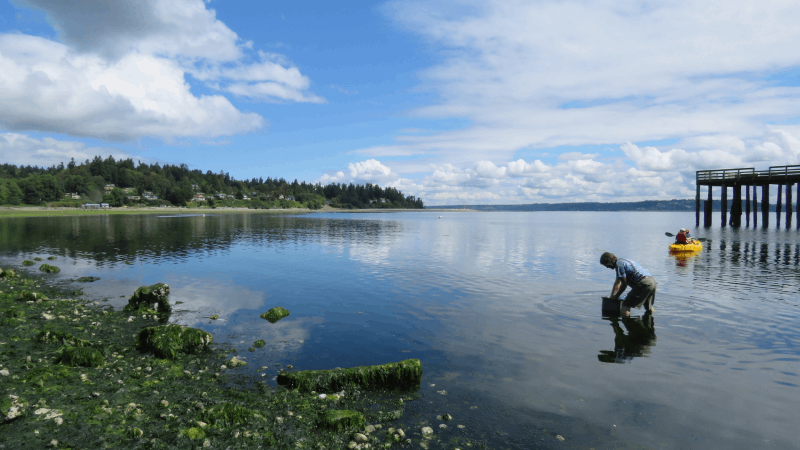Marine Beach Water Quality

Many marine beaches in King County are located in parks that provide a source of recreation. Visitors interact with the water by swimming, wading, kayaking, fishing, and SCUBA diving. These beaches are habitat for many plants and animals that are key to a healthy environment. They provide spawning areas for several types of fish, habitat for young salmon, and are home to other marine life like seaweeds, clams, and crabs.
Marine beaches near urban areas are vulnerable to pollution. Sources of pollution to these beaches may include stormwater pipes, combined wastewater and stormwater (CSO) outfalls, and freshwater creeks and streams. Bacteria and viruses from animal or human poop in the water can cause illnesses in people and animals that interact with contaminated water. Too many nutrients can cause marine plants to become overgrown, which can be a nuisance for people and degrade the water quality of the beach.
We test for signs of poop from humans or animals (indicator bacteria) and track nutrients, temperature, and salinity at marine beaches. We collect water samples monthly from 20 beach sites in King County waters of Puget Sound. Some of these sites have been sampled since the 1970s. Beach water samples are collected by scientists who wade into the water to knee depth and collect a water sample using a sample bottle. Observations about wildlife, beach use, and weather are collected too. Water samples are analyzed at the King County Environmental Laboratory.
More Information
The goals of this monitoring are to:
-
Characterize water quality in King County marine waters near and away from combined wastewater/stormwater inputs.
-
Identify differences in water quality between sampling locations.
-
Track trends (changes) in water quality between sampling years.
-
Compare results to applicable Washington State water quality guidelines.
-
Support coordinated regional monitoring efforts and inform management decisions to keep beaches healthy.
| Parameter | MDL | RDL | Units | Method |
|---|---|---|---|---|
| Fecal coliform | 1 | -- | cfu/100 mL | SM 9222 D |
| Enterococcus | 1 | -- | cfu/100 mL | SM 9230 C |
| Ammonia-nitrogen | 0.002 | 0.01 | mg/L | Kerouel & Aminot 1997 |
| Nitrate/nitrite-nitrogen | 0.01 | 0.04 | mg/L | SM 4500 NO3-F-S |
| Total nitrogen | 0.05 | 0.2 | mg/L | Sm 4500 N-C-S |
| Orthophosphate phosphorus | 0.005 | 0.01 | mg/L | SM 4500 P-F-S |
| Chlorophyll-a | 0.05 | 0.1 | µg/L | EPA 445.0 |
| Salinity | 2 | 3 | PSS | SM 2520 B |
| Temperature | -- | -- | deg C | KCEL SOP #245 |
mdl = method detection limit
rdl = reporting detection limit
cfu = colony forming unit
PSS = practical salinity scale
Download Data
Download data from our online database.
Note: some data may be provisional. Contact MarineWQ@kingcounty.gov for information about the most recent quality control of data.
Documentation
Learn more about our program by reading the latest sampling and analysis plan and other related documents.
Contact us with any questions or access additional resources in the Science Section Library.
 Translate
Translate